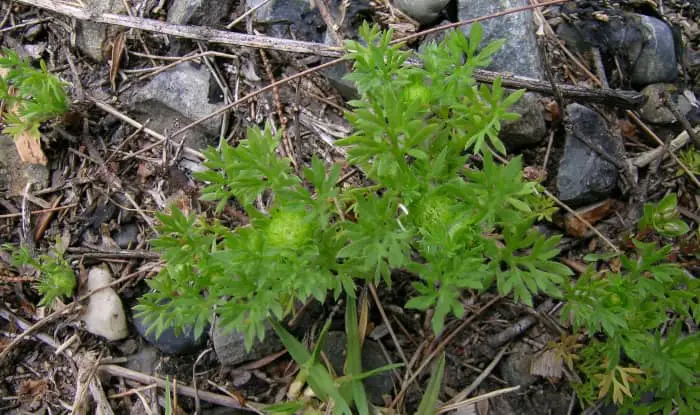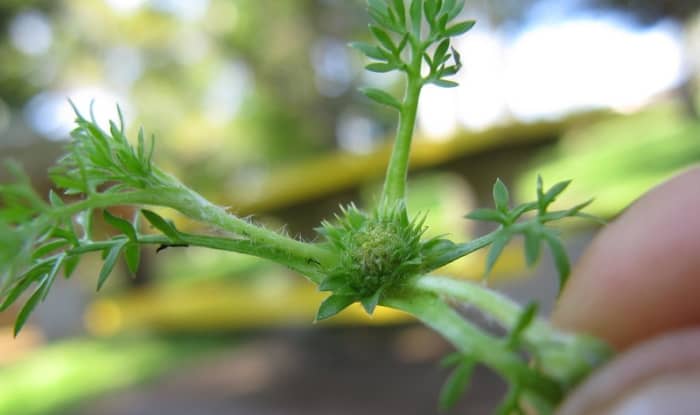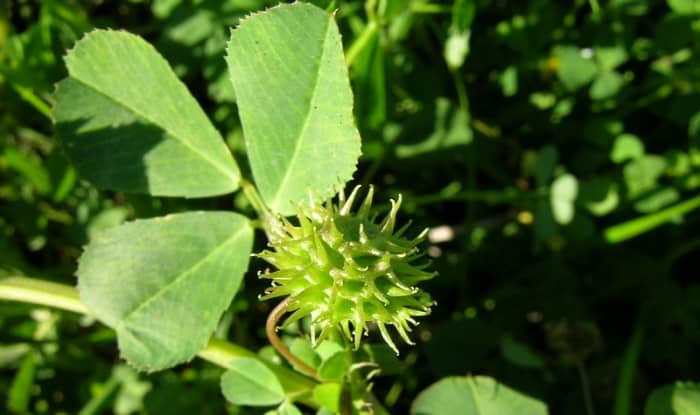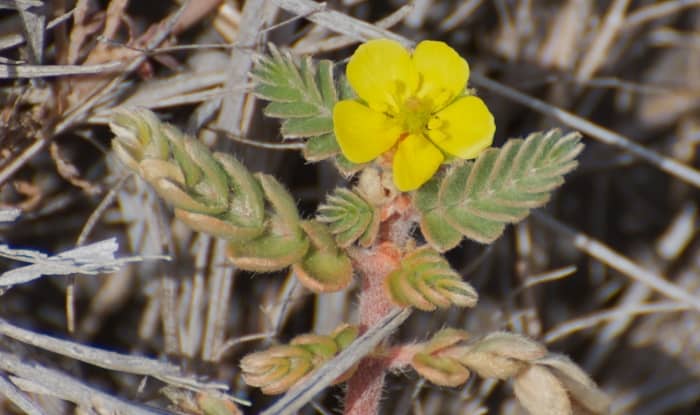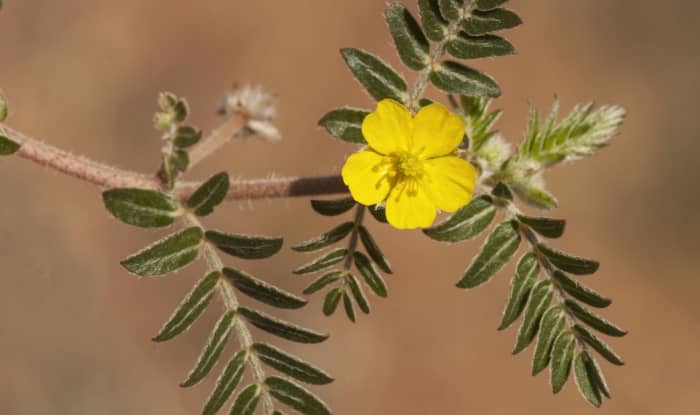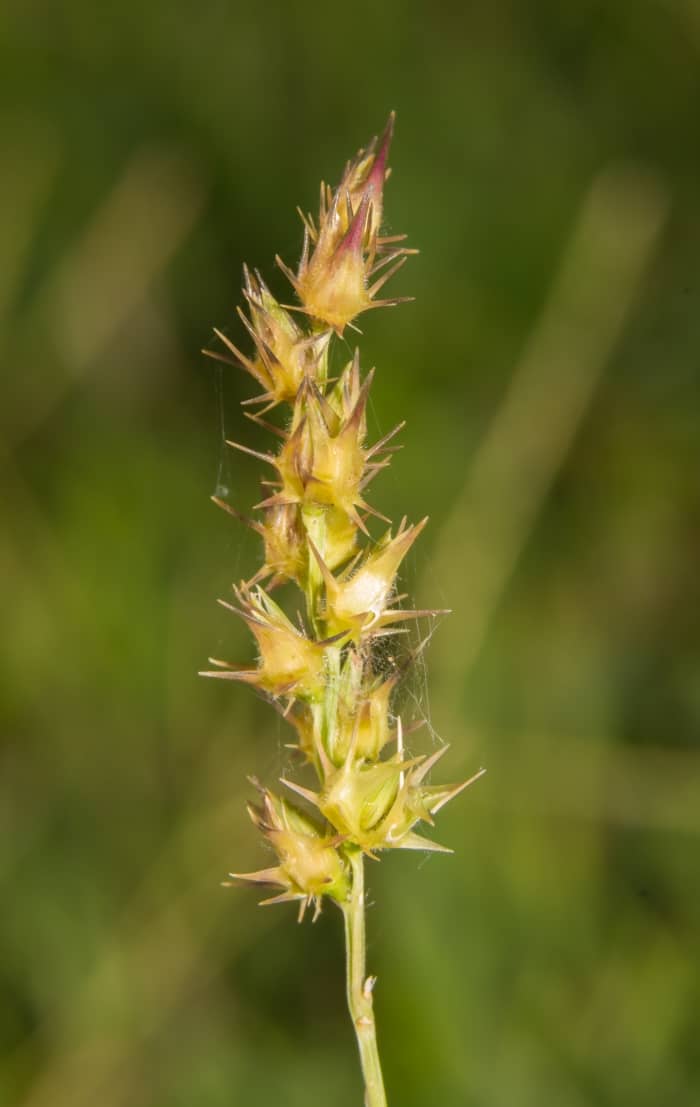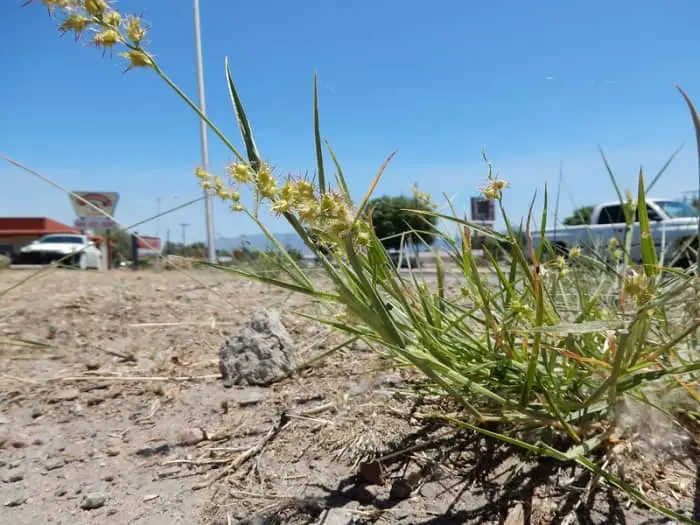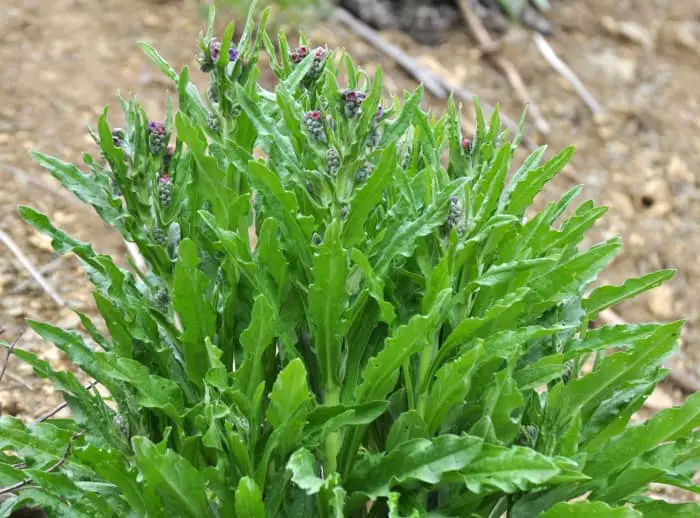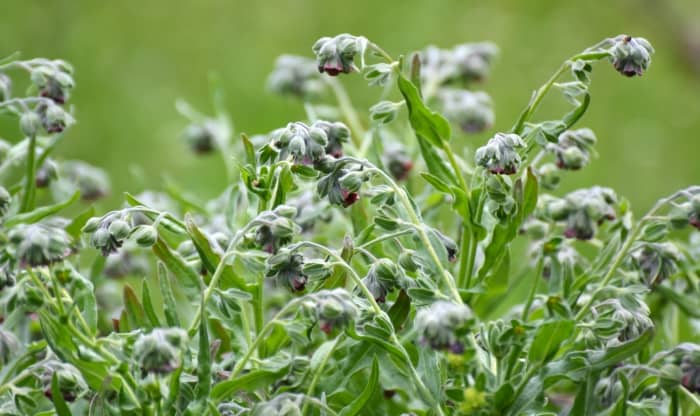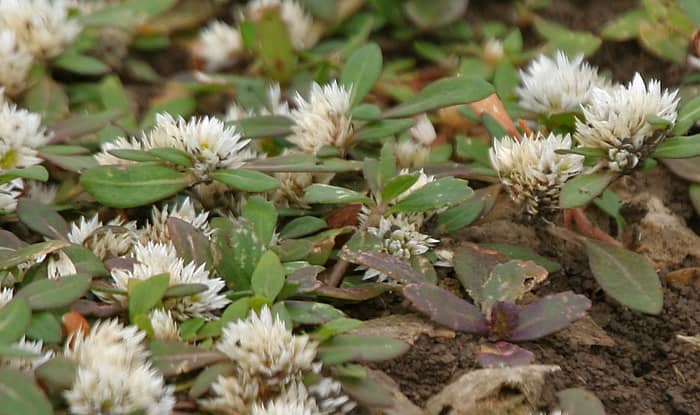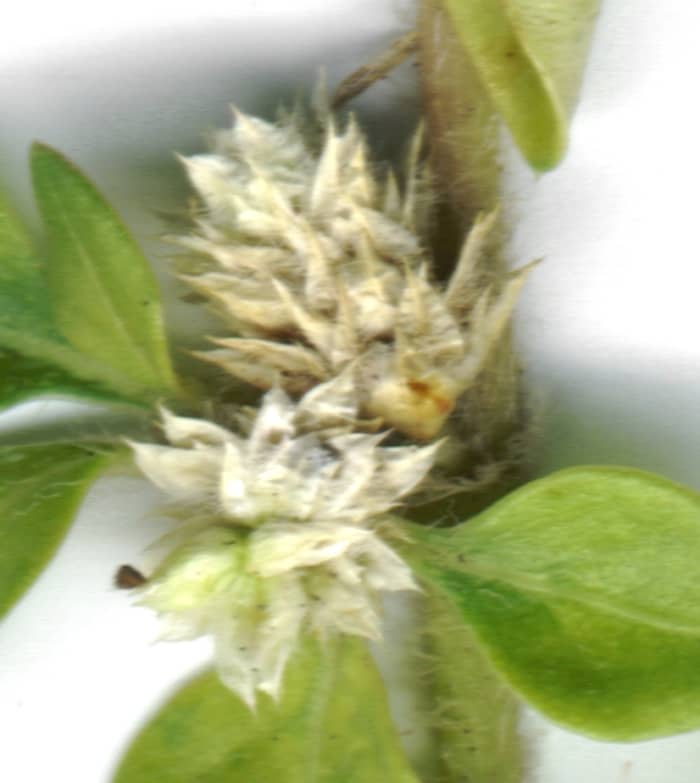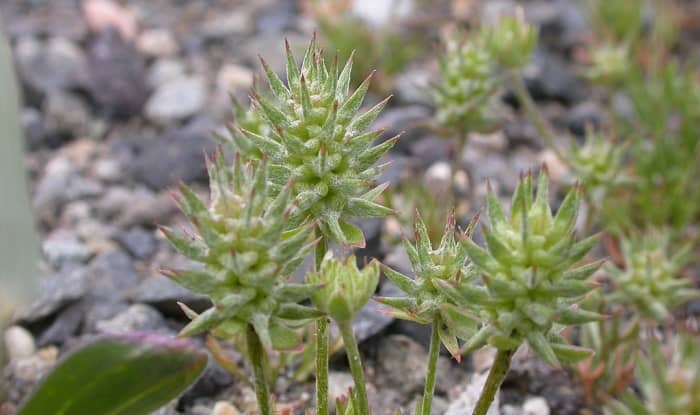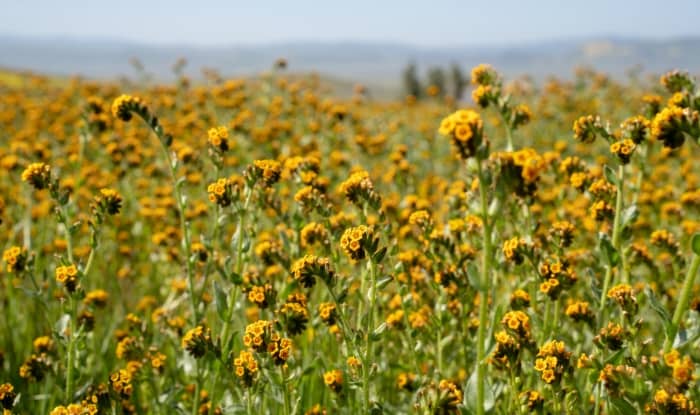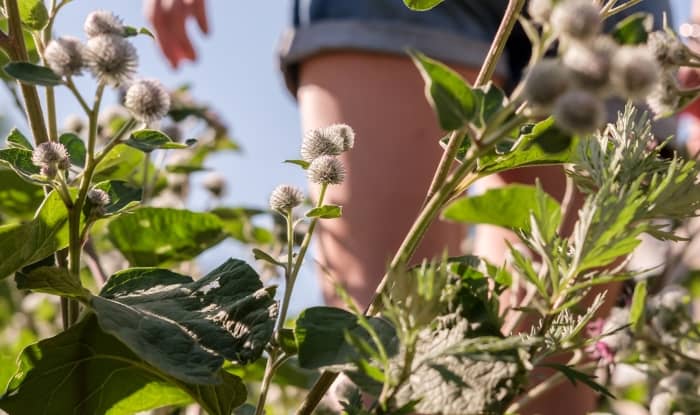Have you found some sticker weeds growing in your yard?
I’ll help you identify the weeds using photos and detailed descriptions.
And I’ll show you how to get rid of them.
Let’s dive in.
Types Of Sticker Weeds
Sticker weeds are a group of weeds with spiky burs that encapsulate their seeds and stick to clothing and animal fur. It’s common to find sticker weeds growing on your lawn, where they pose a menace to bare feet. Many sticker weeds are annual weeds that grow each year from the seeds they disperse.
Here are some of the most common types of sticker weeds you’re likely to come across:
Lawn Burweed (Soliva sessilis)
Lawn burweed is also known as spurweed, bindi weed, and stinging grass. And that final name is a good description of what it feels like to walk on a burweed-infested lawn with bare feet.
Lawn burweed is an annual broadleaf weed that grows during the cool-season. The seeds germinate in the fall. And by the spring, the weed disperses small spiky balls in the grass containing the seeds — the stickers.
SOLIVA SESSILIS FRUIT BY HARRY ROSE
Lawn burweed thrives on thin turf and grows in small patches to a height of 3-4 inches. It produces small, feathery leaves that look like parsley and grow to about 1-½ inches long. In spring, lawn burweed produces tiny flowers that are difficult to see without close inspection.
Burr Medic (Medicago polymorpha)
Burr medic is another sticker-producing weed that’s common to find on your lawn. The weed produces spiky sticker balls after it flowers that eventually dry up and turn brown.
Burr medic has green, serrated-edged leaves that consist of 3 leaflets. They look similar to clover, hence the alternative name for this plant, bur clover.
MEDICAGO POLYMORPHA HARRY ROSE
Hairless, reddish-purple stems extend up to 30 inches as the weed creeps across your lawn. At each place that stem nodes touch the ground, they can root. Between March and June, burr medic produces small yellow flowers.
Other similar burr species in the same family include woolly medic (M. minima), cut-leaved medic (M. laciniata), spotted burr medic (M. arabica), and barrel medic (M. truncatula).
Goat Head Weed (Tribulus terrestris)
Goat head weed is a notorious noxious weed. It also goes by the names puncturevine, devil’s thorn, caltrop, and bindii. The weed has sharp thorns on its fruit that are painful to step on. The stickers can puncture bare feet, thin shoes, bicycle tires, and animal hooves. This helps the plant to spread as the seeds are carried to a new place.
Goat head weed is a very fast-growing weed. After germinating in the spring, it quickly develops deep roots and sends out long stems that creep along the ground. As they spread, the stems form a dense mat.
The stems grow from a central tap root, are covered in hairs, and can reach up to 5 feet long. The weed produces small yellow flowers with 5 petals within a few weeks of germinating.
Field Sandbur (Cenchrus longispinus)
Also called burgrass and spiny sandbur, field sandbur is a summer annual grass weed.
Field sandbur is a troublesome weed in pastures and hay meadows. At maturity, the grass weed develops spiky burrs that can cause injury to grazing cattle and livestock. The burrs contain seeds and stick to fur, hair, and clothing, enabling the weed to spread.
CENCHRUS LONGISPINUS BY MATT LAVIN
The plant has erect or spreading stems that grow up to 1.5 ft. tall with flat green leaves. The plant often has a spreading growth, forming large mats that reach 2 ft. in diameter. The burs grow in clusters of around 20-50 at the end of stems.
Houndstongue (Cynoglossum officinale)
Houndstongue is also called sheep bur, dog’s tongue, beggar’s lice, and woolmat. Originally from Asia and Europe, houndstongue is a noxious weed in many US states. The weed can quickly form dense monocultures that sometimes out-compete desirable plants.
Houndstongue is a biennial weed. During the first year of growth, the weed develops soft, velvety leaves in a rosette. The weed has big leaves, up to 30cm long, that grow alternately up the stem, becoming smaller nearer to the top.
In the second year, the weed produces a flowering stem that can grow up to 4 feet high. From May to June, houndstongue blooms, producing reddish-purple flowers with 5 petals. Clusters of stickers develop from each flower and stick to clothing and animal fur, spreading the seed they contain to new locations.
Houndstongue grows well in disturbed areas such as roadsides and overgrazed pastures. And it’s not unusual to find houndstongue growing in your backyard or flower beds. This weed with stickers is toxic to livestock, and although they usually avoid it, they may eat it if there is a lack of suitable forage.
Khaki Weed (Alternanthera caracasana)
J.M.GARG, CC BY-SA 4.0, VIA WIKIMEDIA COMMONS
Native to Central and South America, khaki weed also grows as an introduced species in the southern United States and Australia, where it’s now considered a noxious weed.
The weed grows in a prostrate manner with reddish stems that reach 60 cm long. Small leaves with smooth margins grow along the stems connected by petioles. From August to October, the plant blooms, producing clusters of tiny white flowers.
FOREST & KIM STARR, CC BY 3.0, VIA WIKIMEDIA COMMONS
The seed heads develop as sticker burs that easily attach to clothing, making it uncomfortable to walk across a lawn with bare feet when they’ve dispersed.
The weed has a large tap root that makes it difficult to get rid of at full maturity without using herbicides.
Bur Buttercup (Ceratocephala testiculata)
BUR BUTTERCUP BY ANDREY ZHARKIKH
Also known as curveseed butterwort, bur buttercup is a summer-annual weed with stickers commonly found in lawns and planting beds.
Bur buttercup is a low-growing sticker weed that first appears in early spring. The plant has light-green leaves covered with white hairs that resemble antlers. Leafless stalks grow beyond the leaves, each developing a small yellow flower when the weed blooms.
MATT LAVIN FROM BOZEMAN, MONTANA, USA, CC BY-SA 2.0, VIA WIKIMEDIA COMMONS
The weed is fast-growing, developing flowers within a few weeks after germination, with the stickers following shortly after. By early summer the plant’s foliage dries and turns brown.
Yellow Burr Weed (Amsinckia sp.)
Yellow burr weed is native to North America but now grows in many other parts of the world. The weed produces many small yellow flowers in a curved spike at the end of branches.
Yellow burr weed grows over 2 feet tall, with an erect stem covered in bristles. The leaves of the plant are oval-shaped and dark green to grey-green. Leaves in the basal rosette grow up to 6-inches long and 1 1/2- inches wide. With alternately growing leaves on the stem that are stalkless. The leaves are covered in short, stiff hairs and feel rough when you touch them.
AMSINCKIA TESSELLATA BY WALTER SIEGMUND, CC BY-SA 3.0
Four seeds form on each wild flower. The seeds develop in a husk covered with spiky bristles — the sticker. When ripe, the seeds fall to the ground. The stickers attach to clothing, shoes, and animal fur, for easy transportation to new locations.
How To Get Rid Of Sticker Weeds From Your Yard
How can you get rid of sticker weeds and their stickers once you find them in your yard?
Here are some suggestions on how you can eradicate these painful spiky weeds and prevent them from returning:
Pick The Stickers By Hand
Once the grass stickers spread around your yard, the only way you can get rid of them is to pick them up by hand.
This is time-consuming, and you may decide it’s not worth the effort as you’ll never be able to get rid of them all. But it will reduce the number of sticker weed plants that return in the next growing season.
There are also tools available (1) that can make the job of removing stickers easier.
If you find stickers on your lawn, sticker weeds must be nearby. So look for the weeds and use the following advice to eradicate them.
Mowing
Mowing your turfgrass regularly can cut sticker weeds down before they have a chance to develop the spiky seed pods.
If the stickers have already developed, it’s important to use a bag attachment on your mower to prevent them from spreading around your yard (2).
Repeated mowing can weaken and eradicate some weeds with stickers over time.
Pull The Weeds Out
Pulling by hand is effective for removing weeds with shallow root systems.
If necessary, water the soil around the base of the weed. Then grip the weed near the soil and pull it out with all the roots.
Some weeds with stickers can regrow from root fragments left in the soil, so make sure to remove any leftover pieces.
Because weeds that develop burrs can be sharp to grab hold of, remember to wear a good pair of gardening gloves.
Perennial weeds with deep and extensive root systems may be impossible to remove by hand. To get rid of these problematic sticker bushes you’ll need something else to help you.
Use A Garden Tool
If you’re having trouble pulling the weed out by hand, use a garden tool.
Using a spade, shovel, or garden fork you can dig around the root zone and loosen the plant, making removal easier.
You can also use these tools to remove any roots that are left in the ground and permanently kill stickers.
You can use a garden hoe to cut weeds down just beneath the surface and stop them from growing to maturity and developing stickers. Repeated hoeing can kill many types of weeds by exhausting the energy store in the roots.
Chemical Herbicides
Chemical post-emergent herbicides kill the sticker weeds that are currently growing in your yard. Selective herbicides can kill broadleaf weeds without harming your lawn. And by choosing a systemic herbicide that kills weeds to the root, you can prevent the sticker weeds from regrowing.
Organic Herbicides
If you don’t like using chemicals, then there are organic methods you can try.
Horticultural vinegar with a 20-30% acetic acid solution can burn and kill weeds. Applying vinegar to the foliage kills the weed above ground and can prevent some weeds from regrowing. For killing weeds that regrow from the root system, you can soak the root zone with vinegar to kill the sticker weed.
Pre-emergent Herbicides
Pre-emergent herbicides can prevent the sticker weeds from growing in your yard (3). When applied to the ground at the right time of year, pre-emergent herbicides prevent weed seeds from developing after germination.
FAQ
Why do weeds have stickers?
The stickers are the weed’s way of dispersing its seeds. At the center of the sticker is a seed pod. When the sticker attaches to clothing, bare feet, or animal fur, the seeds are transported to a new location helping the weed to spread.
Are sticker weeds poisonous?
Sticker weeds are not usually poisonous, but some plants can be toxic when ingested. The spiny burs can sometimes cause injury to animals and anyone who steps on them with bare feet. The stickers themselves are non-toxic when they prick you, but sticker weeds are still some of the worst weeds to find growing in your yard.
References:
- Sticker Burr Roller – https://stickerburrroller.com/
- How To Win The Fight Against Stickers – https://today.tamu.edu/2021/06/09/how-to-win-the-fight-against-stickers/
- Controlling Lawn Burweed: The Spring Lawn “Sticker” – https://nwdistrict.ifas.ufl.edu/hort/2019/11/08/controlling-lawn-burweed-the-spring-lawn-sticker/

